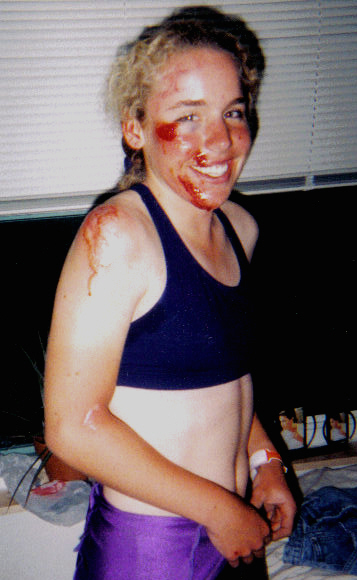A common saying in the cycling world is "It's not if you're going to crash, but when." Crashing is just part of cycling. Experience, skill and some luck can certainly help cyclists avoid crashes, but at some point, if you're riding your bike, you're going to crash.
And when you do you are going to get road rash, abrasions from falling off your bike and making contact with the pavement or some other surface. If your family or child is getting into cycling, it is a good idea to put a first aid kit together with all the supplies you'll need to clean and care for road rash.
Personal Experience
The worst crash of my career came in 1997 when my front wheel collapsed in a freak accident on the velodrome. I don't remember any of it before the emergency room, but it was a pretty nasty crash. Thankfully, my helmet spared me from serious head trauma. I walked away with a very bloody face and shoulder, other random road rash, chipped teeth, black eye and stitches in my chin. Thanks to a very competent and companionate staff at the Colorado Springs Olympic Training Center Sports Medicine Clinic, I don't have a scar on my face! I do have a large one on my shoulder, but I can live with that; it helps hold my purse on my shoulder.

Assess the Damage
Make sure to have your child checked out by a medical professional if her injuries are more serious then superficial abrasions; it's always better to play it safe and take precautions.
If your child's abrasions are deep and bleeding a lot, hold a clean towel or cloth over the wound and apply direct, constant pressure until the bleeding stops. Deep wounds should be checked out by a doctor or paramedic; they may require stitches.
Your child will be able to tell you where the main road rash is, but with everything hurting she may not even be aware of some of it. It's a good idea to lift up her clothing and check out the covered parts of her body. Regardless, she'll find it all when she gets in the shower.
Cleaning Up Abrasions
Use a clean wash cloth, soap and water to gently wash all of the dirt and grime off the road rash. It is a painful process, and it is probably best if a paramedic or someone other than your child cleans the area. It isn't easy to inflict that kind of pain on yourself. The goal is to remove debris from the abrasion without making the wound worse. The sooner the wound can be cleaned after the crash the better. After her wounds are clean, dab them dry, or let them air dry, and dress her wounds.
Dressing the wounds
You can put an anti-bacterial ointment on the wounds, such as Neosporin. Cover the abrasions, not with gauze or a traditional Band-Aid which will allow the abrasion to dry out, but instead with a semi-permeable dressing. These types of dressing keep the abrasion moist, promote healing and decrease the chances of infection. I found I scarred a lot less when I used this type of dressing. Two popular brands are Tegaderm and Second Skin. I always preferred Tegaderm. Make sure to use a piece that covers the entire abrasion. Change the dressing every two or three days; your child can shower with them on.
I found that sometimes. after working out, sweat would pool up under the dressing. When this happened, I'd leave the dressing on, but create a small channel to allow the liquid to drain out.
Ice swollen areas
Icing swollen areas in the first twenty-four to thirty-six hours will aid in your child's recovery. After a crash she should ice swollen areas two to three times a day for 15-20 minutes at a time. Make sure she places a thin layer of cloth between the ice and her skin.
Pain Medication
After a bad crash your child is going to feel like she got hit by a Mack truck. Not only will her road rash hurt, but she will be sore from head to toe. Ibuprofen, or a similar over the counter medication, can help decrease her pain.
Follow-up Care
Fresh pink skin is very vulnerable to the sun. Make sure to apply sun screen to freshly-healed road rash to keep it from burning. I always put vitamin E on my freshly healed road rash to help prevent scarring. If you decide to give it a try, make sure to put old sheets on the bed because vitamin E will stain!
Road Rash isn't a fun part of cycling, but it is a fact of life if you're a cyclist. Knowing how to properly care for road rash will prevent infection and decrease the chances of scarring.
Erin Mirabella is a two-time Olympic track cyclist, mother, MomsTeam's track cycling expert, and children's book author. Her books, Shawn Sheep The Soccer Star and Gracie Goat's Big Bike Race are available online at amazon.com, barnesandnoble.com, borders.com, velogear.com, and at The Olympic Training Centers and select stores. For more information visit Erin's website.
Created May 6, 2010








